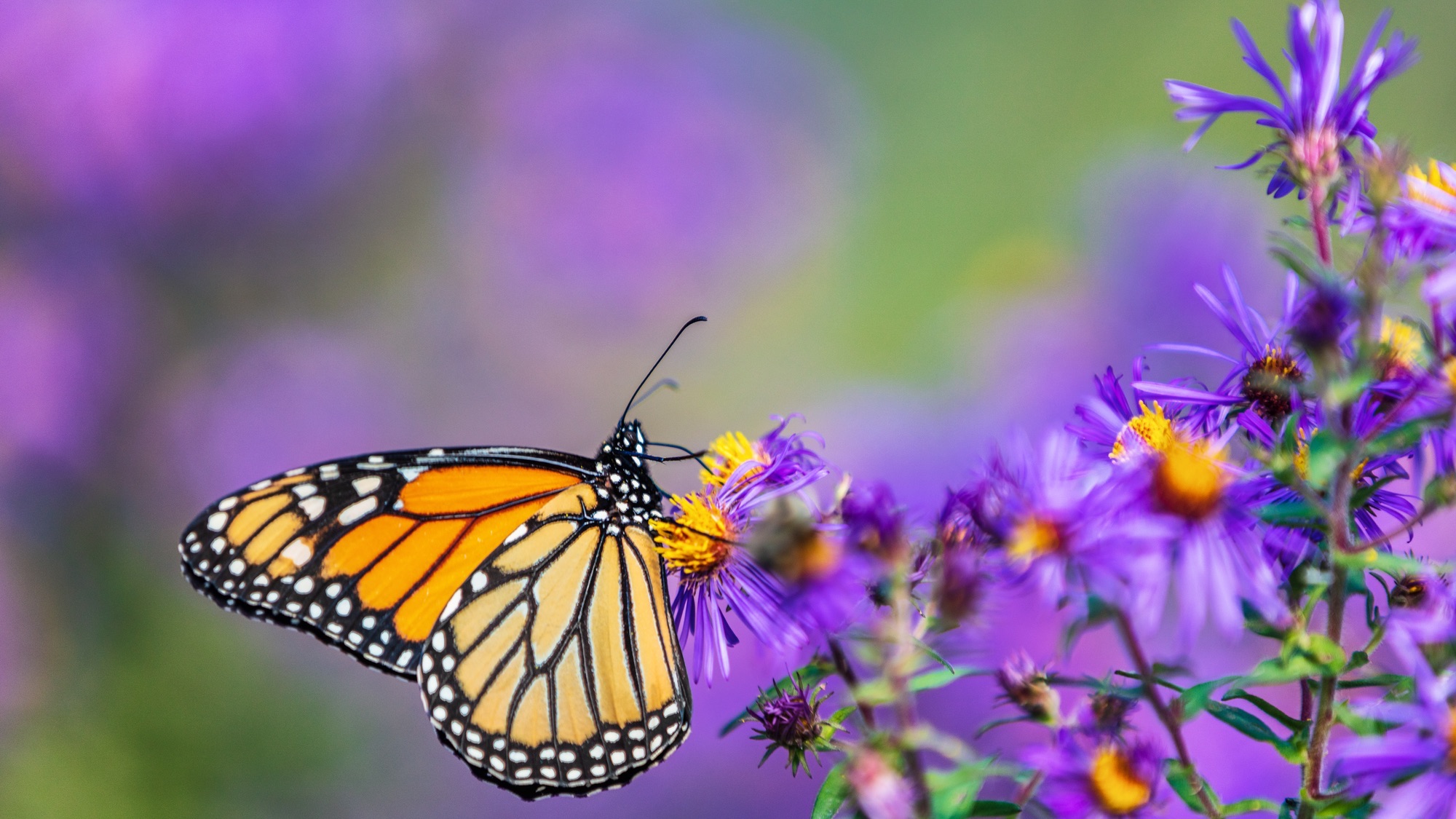

We may earn revenue from the products available on this page and participate in affiliate programs. Learn more ›
Butterflies, like bees, play a crucial role in pollination by transferring pollen between flowers, aiding plant reproduction. A garden that attracts butterflies and other pollinators not only enhances biodiversity but also adds beauty to your outdoor space. Creating a butterfly-friendly garden is simple once you know how to choose the right plants.
Provide nectar-rich flowers
Plants play a vital role in the life cycle of butterflies, primarily by providing nectar, their main food source. Horticulturist Peggy Anne Montgomery from Flowerbulb.eu recommends incorporating single-flowering species into your garden. These plants have a single row of petals surrounding their center, making nectar more accessible to pollinators. Examples of such plants include zinnias, coneflowers, and milkweed.
Montgomery explains, “Double-flowering varieties make it difficult or impossible for pollinators to reach the nectar and pollen.” However, she notes that it is possible to have a garden featuring both types of flowers, but emphasizes the importance of planting plenty of nectar-rich flowers for butterflies and other pollinators.

Provide host plants
Plants provide more than just nectar for butterflies; they are essential for their reproduction. Butterflies need host plants to support their entire lifecycle, from egg to adult. Each butterfly species prefers specific host plants.
Female butterflies lay their eggs on these plants, which serve as a food source for the larvae (caterpillars) once they hatch. The caterpillars feed exclusively on the host plants to grow and develop. When ready to continue their development into butterflies, the caterpillars form pupae on the same host plant, creating a chrysalis and eventually emerging as adult butterflies.
Use native plants
Although some butterflies, like monarchs, migrate, there are species that are native to specific regions. These butterflies rely on native host plants to support their reproduction cycle and provide them with food. Native plants have co-evolved with regional butterfly populations, offering caterpillars the right nutrients and conditions to thrive. Since native plants and butterflies vary by region, research the species in your area. Once you know what species thrives best in your region, you can pick the right plants to help them survive. Although it’s best to use native plants, using a non-native plant species is fine as long as they support the native wildlife and are not invasive.
Common butterfly species and host plants
There are about 750 butterfly species in the United States. While some species are native to specific regions, there are species that can be found in many regions. Plant host plants that support the native species in your region first, and then consider adding host plants that support some of these butterfly species:
- Monarch: Milkweed
- Swallowtail: Parsley, dill, and fennel
- Painted Lady: Thistles and hollyhocks
- Cabbage White: Cabbage and broccoli
- Fritillaries: Violets
Include early spring bloomers
Spring and summer are peak times for pollinators, offering them a wide selection of natural resources in both wild settings and gardens. However, securing blooms for late fall, winter, and early spring requires careful planning and effort. “Most butterflies hibernate as eggs, caterpillars, or pupae, while a few hibernate as adults,” explains Montgomery. To ensure their survival, butterflies need an early food source in spring. Montgomery notes that butterflies typically begin to fly when temperatures reach at least 65°F. Planting early-blooming bulbs in late fall—such as grape hyacinth (Muscari), ornamental onions (Allium), anemones (Anemone coronaria), and bluebells (Hyacinthoides)—provides a reliable food source for butterflies. “Allium is an excellent choice because it includes many varieties that bloom at different times,” adds Montgomery. Other early bloomers favored by butterflies include dogwood, forsythia, lilacs, redbud, and Bleeding Heart.
Invest in perennials for non-fuss blooms
Perennials add color and variety to gardens, regrowing annually to eliminate the need for replanting each season. Once established, they require minimal maintenance. Bulbs are a straightforward way to introduce single-flowering plants to your garden, providing color throughout the year. Although not all bulbs are perennial, many, such as alliums, anemones, crocus, and Muscari are, and butterflies love them.
“Generally speaking, bulbs bloom for two to four weeks,” Montgomery states. “To achieve continuous bloom, it’s best to plant a variety of bulbs that bloom at different times.” She further explains that bulb catalogs and online sources categorize bloom times as mid-spring, late spring, early summer, and so forth. Therefore, it’s crucial to understand your growing zone and select varieties with staggered bloom times to ensure a vibrant garden throughout the seasons.
Provide a water source
All life requires water to survive. However, butterflies cannot land on water to drink, making bird baths and garden ponds ineffective for hydration. Instead, create a puddling station—a shallow puddle or damp area that provides butterflies with essential minerals and water.
To construct a puddling station:
- Fill a shallow pan or dish with dirt
- Add 1 teaspoon of salt,
- If available, a few spoonfuls of garden compost
- Slowly add water until the soil reaches a thick, muddy consistency
- Arrange small rocks on top to offer butterflies a place to land. Position the puddling station near flowering plants.
To maintain optimal moisture and nutrient levels, replenish the water, salt, and compost monthly.
Avoid pesticides
Chemical pesticides can harm butterflies and other pollinators, potentially killing them or damaging their natural food sources. If you encounter a pest problem, adopt a targeted approach. Regularly inspect your plants to detect pests, using a strong water blast or handpicking to remove them. For severe infestations, opt for milder insecticides like cold-pressed neem oil, which controls various garden pests and diseases without the severe impacts of synthetic chemicals. However, misuse of neem oil can still threaten pollinators, so apply it early in the morning or late in the day when beneficial insects are less active. Always follow package instructions meticulously to avoid harming butterflies. Additionally, consider employing beneficial insects or natural repellents to safeguard your garden while maintaining a butterfly-friendly environment.